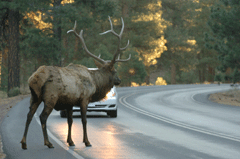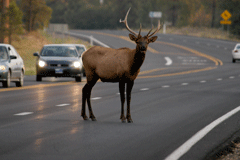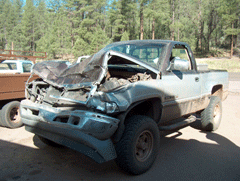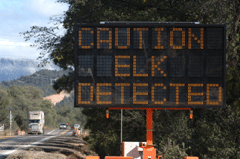Wildlife Crossings
Air Date: Week of March 9, 2007

Highway 260 just east of Payson, Arizona. (Arizona Game and Fish Department.)
Collisions between elk and highway motorists are increasing in Arizona. Now, wildlife officials have hit on an unusual solution that grabs drivers' attention. Gillian Ferris Kohl reports.
Transcript
GELLERMAN: Arizona is the fastest growing state in the country. More people means more of everything, including encounters between humans and wildlife. In Payson, a small town in northern Arizona, state officials have created an innovative way to reduce collisions between cars and animals.
Arizona Public Radio’s Gillian Ferris Kohl reports.
KOHL: It can be an upsetting experience to run over a squirrel as it skitters off the road. But it’s a different experience altogether when a six hundred pound elk comes crashing through your windshield.

Highway 260 just east of Payson, Arizona.(Arizona Game and Fish Department.)
KOHL: That’s Bob Tusso, a hydrogeologist from Flagstaff. He hit and killed an elk last year, driving seventy five miles an hour. Tusso says she was as big as his Subaru.
TUSSO: Her body hit about at the top of the windshield and smashed it where it connects to the roof. If you see pictures of the car, it looks like somebody got totally flattened in there. They had to cut off the roof, put on a new windshield, a new hood. I still find pieces of elk, or elk hair in the upholstery and whatever when I clean out the car.

A truck destroyed by an elk collision on Highway 260 just east of Payson, Arizona. (Arizona Game and Fish Department.)
[SOUNDS OF THE HIGHWAY]
KOHL: Highway 260 outside of Payson has a particularly high accident rate. Like many Arizona highways, it has only two lanes and winds through mountainous terrain with plenty of blind corners and sheer drop-offs. Researchers here are conducting an experiment to teach drivers – and animals – to, essentially, “look both ways.” On this cold morning, Jay Vagalatos stands on the side of Highway 260 in front of an open metal shed full of computers.
VAGALATOS: Basically, what we have up there two thermal cameras which are aimed at the detection zones. We don’t want squirrels settin’ em off. We kind of want large hot objects like humans or elk, deer, possibly even like a large mountain lion would set it off but that’s a good thing too.
KOHL: Vagalatos designed the software for the wildlife crosswalk. The animals are routed to the crossing by a series of low-voltage electrified fences. Then the computers send a real time warning to drivers that large animals are close by.
VAGALATOS: What it does.. It’ll send a signal to a radio. It fires off the flashers sends another radio signal to the message boards which fire off a message that say “elk detected. Slow Down”
KOHL: Yellow-flashing lights force a driver’s immediate attention to the road. Vagalatos believes the system is much more effective than roadside signs like those warning drivers to watch for elk for the next forty miles.

Elk crosswalk warning signs on Highway 260 just east of Payson, Arizona. (Arizona Game and Fish Department)
KOHL: The Arizona Game and Fish Department is pleased with the results. Norris Dodd is project coordinator.
DODD: Lo’ and behold, in the year after they fenced, the collision rate went down eighty three percent so really the net result is we’re making not only a highway that’s better for people and safer but better for animals.
KOHL: And, 11 new underpasses give the animals additional places to cross the highway. But, Dodd says, the success of the project ultimately depends on drivers.

Highway 260 just east of Payson, Arizona.
(Arizona Game and Fish Department.)
DODD: In one two-day period, we had 136 vehicles going over 105 miles an hour and this is an area posted at 55 miles per hour. Sometimes I kind of promote the notion that we oughta leave all the dead animals on the side of the road so all the people will get the visual clue that maybe they need to slow down.
[JINGLING BELL SOUNDS]
KOHL: Much of the data for the project is collected by the animals themselves.
KOHL: Dodd has trapped more than a hundred elk and outfitted them with GPS data collection collars.
[ELK BARKING]
KOHL: The collars track the elks’ migration patterns, including how many times they cross or even come close to the highway. This morning, Dodd finds a female yearling in one of the traps. He and his crew blind fold her and put on her thick necklace.
[SOUNDS OF TAGGING ELK AND ELK BARKING]
KOHL: The elk will wear the collar for 22 months when a pre-set explosive charge will blow it off her. Game and Fish researchers will use the data to continue work on this highway and elsewhere in Arizona. Canada and Michigan are conducting similar experiments.
For Living on Earth, I’m Gillian Ferris Kohl, in Payson, Arizona.
Links
Living on Earth wants to hear from you!
Living on Earth
62 Calef Highway, Suite 212
Lee, NH 03861
Telephone: 617-287-4121
E-mail: comments@loe.org
Newsletter [Click here]
Donate to Living on Earth!
Living on Earth is an independent media program and relies entirely on contributions from listeners and institutions supporting public service. Please donate now to preserve an independent environmental voice.
NewsletterLiving on Earth offers a weekly delivery of the show's rundown to your mailbox. Sign up for our newsletter today!
 Sailors For The Sea: Be the change you want to sea.
Sailors For The Sea: Be the change you want to sea.
 The Grantham Foundation for the Protection of the Environment: Committed to protecting and improving the health of the global environment.
The Grantham Foundation for the Protection of the Environment: Committed to protecting and improving the health of the global environment.
 Contribute to Living on Earth and receive, as our gift to you, an archival print of one of Mark Seth Lender's extraordinary wildlife photographs. Follow the link to see Mark's current collection of photographs.
Contribute to Living on Earth and receive, as our gift to you, an archival print of one of Mark Seth Lender's extraordinary wildlife photographs. Follow the link to see Mark's current collection of photographs.
 Buy a signed copy of Mark Seth Lender's book Smeagull the Seagull & support Living on Earth
Buy a signed copy of Mark Seth Lender's book Smeagull the Seagull & support Living on Earth

